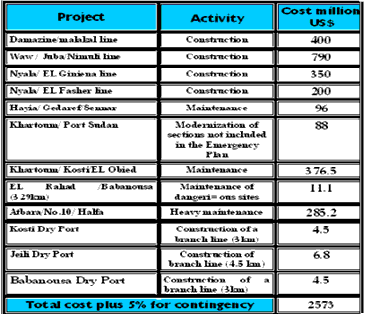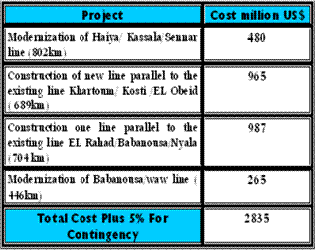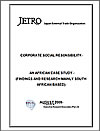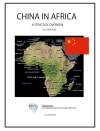 Sudan Railways Corporation (SRC)
Sudan Railways Corporation (SRC)
All data are collected in the Fiscal Year of 2008-2009.
Company Profile and History
SRC operates one of the longest railways in Africa. It operates a 5898 km long single line of 1.067 mm gauge. Construction of the railway lines started in 1897 and most of the track was constructed before 1930. The railway’s main route extends from Port Sudan via Atbara to Khartoum with an alternate link between Haya and Sennar via Kassala. There are also branch lines north to Karima and Wadi Halfa.
SRC at present owns 130 mainline locomotives, 54 shunting locomotives, 4187 freight wagons, 910 tank wagons and 167 passenger coaches. Main workshops for heavy repairs of rolling stock, signalling and telecommunication equipment are concentrated in Atbara. The city also accommodates a workshop for wagon rehabilitation and maintenance, in addition to the ones in Khartoum and Port Sudan.
The rail system was constructed as an adjunct to military operations, although the first line, built in the mid-1870s from Wadi Halfa to a point about 54 km upstream on the Nile River, was initially a commercial undertaking. This line, which had not proved viable commercially, was extended in the mid-1880s and again in the mid-1890s to support the Anglo-Egyptian military campaigns against the Mahdiyah. Of little other use, it was abandoned in 1905.
The first segment of the present-day Sudan Railways, from Wadi Halfa to Abu Hamad, was also a military undertaking; it was built by the British for use in General Herbert Kitchener's drive against the Mahdiyah in the late 1890s. The line was pushed to Atbarah during the campaign and after the defeat of the Mahdiyah in 1898 was continued to Khartoum, which it reached on the last day of 1899. The line was built to 1067 mm gauge track specifications, the result apparently of Kitchener's pragmatic use of the rolling stock and rails of that gauge from the old line. This gauge was used in all later Sudanese mainline construction.
The line opened a trade route from central Sudan through Egypt to the Mediterranean and beyond. It became uneconomic because of the distance and the need for trans-shipment via the Nile, and in 1904 construction of a new line from Atbarah to the Red Sea was undertaken. In 1906 the new line reached recently built Port Sudan to provide a direct connection between Khartoum and ocean-going transport.
During the same decade, a line was also built from Khartoum southward to Sannar, the heart of the cotton-growing region of Al Jazirah. A westward continuation reached Al Ubayyid, then the country's second largest city and centre of gum arabic production, in 1911. In the north, a branch line was built from near Abu Hamad to Kuraymah that tied the navigable stretch of the Nile between the fourth and third cataracts into the transport system. Traffic in this case, however, was largely inbound to towns along the river, a situation that still prevailed in 1990.
In the 1920s, a spur of the railway was built from Taqatu Hayya, a point on the main line 200 km southwest of Port Sudan, south to the cotton-producing area near Kassala, then on to the grain region of Al Qadarif, and finally to a junction with the main line at Sannar. Much of the area's traffic, which formerly had passed through Khartoum, has since moved over this line directly to Port Sudan.
The final spur of railway construction began in the 1950s. It included extension of the western line to Nyala (1959) in Darfur Province and of a south-westerly branch to Wau (1961), southern Sudan's second largest city, located in the province of Bahr el Ghazal. This essentially completed the Sudan Railways network, which in 1990 totalled about 4800 route km.
Conversion of Sudan Railways to diesel fuel started in the late 1950s, but a few mainline steam locomotives continued in use in 1990, serving lines having lighter weight rails. Through the 1960s, rail essentially had a monopoly on transportation of export and import trade, and operations were profitable. In the early 1970s, losses were experienced, and, although the addition of new diesel equipment in 1976 was followed by a return to profitability, another downturn had occurred by the end of the decade. The losses were attributed in part to inflationary factors, the lack of spare parts, and the continuation of certain lines characterized by only light traffic, but retained for economic development needs and for social reasons.
The 1980s saw a steady erosion of tonnage as a result of a combination of inefficient management, union intransigence, the failure of agricultural projects to meet production goals, the dearth of spare parts, and the continuing civil war. The bridge at Aweil was destroyed in the 1980s and Wau is currently without rail access. During the civil war in the south (1983-2005) military trains went as far as Aweil accompanied by large numbers of troops and militia, causing great disruption to civilians and humanitarian aid organisations along the railway line.
The majority of the railway track network remains decrepit, and at least one third is non-operational. Sudan Today, the SRC carries less than 6 percent of the country’s traffic on a network that is both unreliable and slow, with an average commercial speed of 10 to 30 km/h.
The participation of the private sector was introduced in 1999. At the time Sheiko was asked to run a passenger train between Rahad and Babanusa stations in the western region for a distance of 698 kilometres. The company paid US$384616 to rehabilitate 20 coaches, and in 2001, imported three mainline locomotives to help its passenger trains.
Sayga Flour Mill Company was also asked to assist with the transportation of wheat from Port Sudan to Khartoum, a distance that is about 787 kilometres. The company financed the cost for rehabilitation of hoppers and provided the necessary spare parts for rehabilitation of the required wagons/locomotives. The government also structured a deal with EL Bazim to run freight trains along the main corridor from Port Sudan to Khartoum. EL Bazim, like other companies, financed the necessary spare parts for rehabilitation of 300 freight wagons and six mainline locomotives which were out of order, at a total cost of US$5.1 million.
In Country Location
Sudan Railways Corporation Building, Al Tabia Stree, Khartoum, Sudan; Tel: +249 183-774009; Fax: +249 183-770652
Services and Products
The corporation is engaged in transporting passengers and general freight
Number of Employees
9,923 employees
Financial Information
SRC is in serious financial difficulties and suffers from the effects of over-staffing, delayed maintenance, and US sanctions on Sudan. No details on revenue available
Market Share
Sudan Railways Corporation (SRC) set up as a monopoly operator
Business Objective
To become profitable with the assistance of international and private partners
Business Model
The French Railways Consultancy Centre was tasked by SRC to draw up a railway Master Plan for the period 2007-2026. The plan was finalized in 2006. Highlights from the plan are as follows:
The plan is divided into three periods which include: Emergency period covering the period 2007-2011; recovery period covering 2012-2017; and the expansion period covering the period 2017-2026.
Emergency Phase: Maintain the role of the railways as the backbone of transport; enhancing its services to major clients; stabilization and development of its share in the market; repair of the most dilapidated infrastructure; technical studies for network expansion inland; improving rolling stock; and improving operational efficiency.



Operational Results at the End Of year 2011: Tons = 3 million; Ton km = 2250 million; Passengers = 300 million; Passenger km= 195 million
Medium Term plan (2012-2017): Strengthening and extension of railway lines: Juba-Nimuli (790km); Damazine-Malakal (400km); Nyala-EL Giniena (350km); Nyala-EL Fasher (200km); and privatization of all operational activities.

Operation Results at the end of the year 2017: Tons = 6.5 million; Ton km = 5.700 million; Passengers = 3 million; Passenger km = 2.400 million
Long Term Phase (2018-2026): enhancing the competitive position of the railway by expanding and improving services; construction of railway links between Sudan and the neighbouring countries (Uganda, Ethiopia, Chad, Central Africa, Kenya, Egypt).

Operation Results at the End of the year 2026: Tons = 19.5 million; Ton km = 13,694 million; Passengers = 5 million; Passenger km = 3,000 million;
Ownership of Business
SCR is wholly owned by the government
Benefits Offered and Relations with Government
The Government of Sudan launched a study designed to enhance private sector participation (PSP) in the rail network through improved institutional and legal frameworks. The study’s goal was to optimize the role of the rail network in order to boost economic growth in Sudan. The study was financially and technically supported by the National Emergency Transport Rehabilitation Project (NETREP), and the Multi Donor Trust Fund for Sudan (MDTF-NS), managed by the World Bank.
Main findings and the agreed options are as follows: The stakeholders agreed to address the fundamental issues impeding effective PSP in railways, including: liberalization of tariff rates; network improvements to increase line speed and reliability; resolution of the SRC’s role as both railway manager and operator; and an update of legislation affecting competition between rail and road transport.
Moving forward, the study found that management of the track and the operation of services should be separated. In addition, the study recommended the establishment of a regulatory body, which initially could be part of the Ministry of Transport, Roads and Bridges, but in the medium term should gain a significant degree of autonomy. The study also reaffirmed the need for the Sudanese government to continue with its efforts to re-establish the rail network as a leader in the logistics of freight and passenger movement in the country, by redefining its role as a policy maker and investor in the rail network.
The future role of the SRC will be to tackle the deficiencies in the fixed infrastructure in order to allow the PSPs to provide a higher quality and more reliable service. With the transfer of staff to new jobs and the inevitability of redundancy among some of the staff, training and education is a major factor in the success of these changes at a strategic level and in human social terms.
Currently the study is in the process of being integrated into the National Transport Mater Plan.
Product Development
The latest extensions include new lines for transportation of Sudanese crude oil constructed between EL Mujlad and Abu Jabra (52 kms); between the refinery in Abu Khiraiz and EL Obeid station ( 0 kms); and the Merwi Dam branch line from EL Ban station all completed between 1996 and 2002.
The Federal Ministry of Transportation, Roads and Bridges announced on 16 August 2009 the completion of renovation of the historical Babanusa-Awil railway.
2008 saw work begin on the rehabilitation of the railway line between Babanousa and Wau. Sudan and China also signed a contract to upgrade the railway line between Khartoum and Port Sudan, converting it to a dual carriage line that meets international standards.




